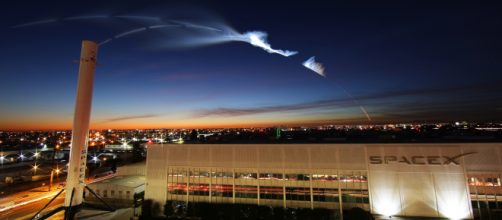Elon Musk, outside of digging tunnels and selling flamethrowers, has another big project that's out of this world. No one will blame you if you haven't been keeping up with the scientific side of things this year. 2018 has had a busy start with huge events like the State of the Union address and the Super Bowl filling the news. SpaceX's newest rocket, for me, takes the cake in terms of the most significant event of the year so far. The Falcon Heavy launched Tuesday from the NASA Kennedy Space Center at 3:45 PM ET. The risky nature of the launch made it a massive event for spectators, and the successful liftoff and touchdown of the stage one cores could be considered an enormous success.
The second stage core, however, did have a complication with its landing, despite delivering its payload. It's still a great success, after all, landing rockets is tough, and the launch of the Falcon Heavy with its reusable cores could lead to more economical space travel, and eventually, missions to the moon and Mars. The successful launch is just the next step in SpaceX's plans, with the rest of the scientific community sure to follow suit, I'm beginning to look forward to the future of space travel.
How it works
Of course, there's a good reason to call the Falcon Heavy the most powerful rocket ever. With its multistage cores, it creates almost 23 thousand kilonewtons (around 5.13 million pounds) of thrust on liftoff, bringing into orbit nearly 64 metric tons (141,000lb) of payload.
This massive amount of force is generated by the 27 Merlin engines operating at full thrust. Each of the three cores contains nine individual engines, putting out about 849kN (190,000lbf) per.
After the first stage, the two side cores split off and return to the launch pad to be reused. The central core delivers the payload to orbit, restarting multiple times to release payloads into a variety of orbits. After completing its objective, the core will land at a separate drone landing pad, allowing for it to be reused as well.
The 'Starman'
People love the launch of the massive rocket and what it entails for the future of space travel. Scientists, journalists, and thousands of others are tweeting hourly about the Falcon Heavy.
The "Starman" is an astronaut dummy that was sent up in a Tesla Roadster as the payload for the demo launch and has achieved temporary fame as he leaves beyond Mars' orbit, continuing out into the depths of space.
The Starman will be our first ambassador of the far reaches of our galaxy, and the Falcon Heavy could be the next step in going beyond that.
View from SpaceX Launch Control. Apparently, there is a car in orbit around Earth. pic.twitter.com/QljN2VnL1O
— Elon Musk (@elonmusk) February 6, 2018


